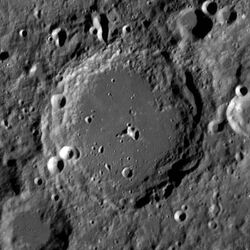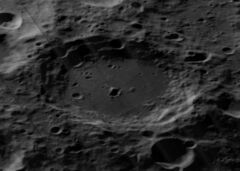Astronomy:Carnot (crater)
 LRO image | |
| Diameter | 126.06 km |
|---|---|
| Depth | Unknown |
| Colongitude | 146° at sunrise |


Carnot is a large crater in the northern part of the Moon's far side. It was named after Nicolas L. S. Carnot by the IAU in 1970.[1]
The outer rim of Carnot has a somewhat hexagonal form, particularly in the southern half. The northern rim has an irregular inner wall, while the southern face is terraced and has a sharper outer edge. There is some slumping along the rim edge to the southeast, producing outward bulges in the perimeter. The western inner wall is partly overlaid by three small, cup-shaped craters. Within the rim, the crater floor is flat and level, at least in comparison to the rugged terrain around the exterior. Just to the southeast of the crater midpoint is a central peak formation. The interior floor is marked by several small and numerous tiny craters. The most prominent of the craters on the floor is a small, shallow crater near the southern inner wall.
Carnot intrudes into the southern rim of the huge walled plain Birkhoff. To the west-southwest of Carnot is the crater Paraskevopoulos.
Carnot is a crater of Nectarian age.[2]
Satellite craters
By convention these features are identified on lunar maps by placing the letter on the side of the crater midpoint that is closest to Carnot.
| Carnot | Latitude | Longitude | Diameter |
|---|---|---|---|
| F | 52.5° N | 138.9° W | 35 km |
References
- ↑ Carnot, Gazetteer of Planetary Nomenclature, International Astronomical Union (IAU) Working Group for Planetary System Nomenclature (WGPSN)
- ↑ The geologic history of the Moon. USGS Professional Paper 1348. By Don E. Wilhelms, John F. McCauley, and Newell J. Trask. U.S. Government Printing Office, Washington: 1987. Table 9-4.
- Andersson, L. E.; Whitaker, E. A. (1982). NASA Catalogue of Lunar Nomenclature. NASA RP-1097.
- Blue, Jennifer (July 25, 2007). "Gazetteer of Planetary Nomenclature". USGS. http://planetarynames.wr.usgs.gov/.
- Bussey, B.; Spudis, P. (2004). The Clementine Atlas of the Moon. New York: Cambridge University Press. ISBN 978-0-521-81528-4.
- Cocks, Elijah E.; Cocks, Josiah C. (1995). Who's Who on the Moon: A Biographical Dictionary of Lunar Nomenclature. Tudor Publishers. ISBN 978-0-936389-27-1. https://archive.org/details/isbn_9780936389271.
- McDowell, Jonathan (July 15, 2007). "Lunar Nomenclature". Jonathan's Space Report. http://host.planet4589.org/astro/lunar/.
- Menzel, D. H.; Minnaert, M.; Levin, B.; Dollfus, A.; Bell, B. (1971). "Report on Lunar Nomenclature by the Working Group of Commission 17 of the IAU". Space Science Reviews 12 (2): 136–186. doi:10.1007/BF00171763. Bibcode: 1971SSRv...12..136M.
- Moore, Patrick (2001). On the Moon. Sterling Publishing Co.. ISBN 978-0-304-35469-6. https://archive.org/details/patrickmooreonmo00patr.
- Price, Fred W. (1988). The Moon Observer's Handbook. Cambridge University Press. ISBN 978-0-521-33500-3.
- Rükl, Antonín (1990). Atlas of the Moon. Kalmbach Books. ISBN 978-0-913135-17-4.
- Webb, Rev. T. W. (1962). Celestial Objects for Common Telescopes (6th revised ed.). Dover. ISBN 978-0-486-20917-3. https://archive.org/details/celestialobjects00webb.
- Whitaker, Ewen A. (1999). Mapping and Naming the Moon. Cambridge University Press. ISBN 978-0-521-62248-6.
- Wlasuk, Peter T. (2000). Observing the Moon. Springer. ISBN 978-1-85233-193-1.
 |


